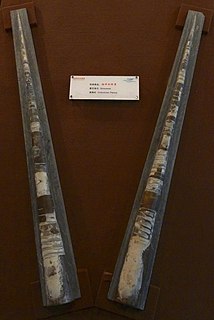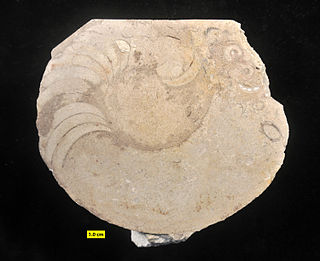The Devonian is a geologic period and system of the Paleozoic, spanning 60 million years from the end of the Silurian, 419.2 million years ago (Mya), to the beginning of the Carboniferous, 358.9 Mya. It is named after Devon, England, where rocks from this period were first studied.

The Nautilida constitute a large and diverse order of generally coiled nautiloid cephalopods that began in the mid Paleozoic and continues to the present with a single family, the Nautilidae which includes two genera, Nautilus and Allonautilus, with six species. All told, between 22 and 34 families and 165 to 184 genera have been recognised, making this the largest order of the subclass Nautiloidea.
Discosorida are an order of cephalopods that lived from the beginning of the Middle Ordovician, through the Silurian, and into the Devonian. Discosorids are unique in the structure and formation of the siphuncle, the tube that runs through and connects the camerae (chambers) in cephalopods, which unlike those in other orders is zoned longitudinally along the segments rather than laterally. Siphuncle structure indicated that the Discosorida evolved directly from the Plectronoceratida rather than through the more developed Ellesmerocerida, as did the other orders. Finally and most diagnostic, discosorids developed a reinforcing, grommet-like structure in the septal opening of the siphuncle known as the bullette, formed by a thickening of the connecting ring as it draped around the folded back septal neck.

Ormoceras is an actinocerid nautiloid genus and type for the family Ormoceratidae, found in North America from the late Chazyan though the early Cincinnatian of the Middle and Upper Ordovician, but which continued through the Devonian worldwide.

Atrypa is a genus of brachiopod with shells round to short egg-shaped, covered with many fine radial ridges, that split further out and growthlines perpendicular to the costae and 2-3 times wider spaced. The pedunculate valve is a little convex, but tends to level out or even become slightly concave toward the anterior margin. The brachial valve is highly convex. There is no interarea in either valve. Atrypa was a cosmopolitan and occurred from the late Lower Silurian (Telychian) to the early Upper Devonian (Frasnian). Other sources expand the range from the Late Ordovician to Carboniferous, approximately from 449 to 336 Ma. A proposed new species, A. harrisi, was found in the trilobite-rich Floresta Formation in Boyacá, Colombia.
The Actinocerida comprise an order of generally straight, medium to large cephalopods that lived during the early and middle Paleozoic, distinguished by a siphuncle composed of expanded segments that extend into the adjacent chambers, in which deposits formed within contain a system of radial canals and a narrow space along the inner side of the connecting ring known as a paraspatium. Septal necks are generally short and cyrtochoanitic, some being recumbent, some hook shaped. Most grew to lengths of about 60 to 90 cm but some, like the Huroniidae of the Silurian grew significantly larger.
The Acleistoceratidae is a family of oncocerids that contains genera characterized by depressed exogastric brevicones and cyrtocones that range from the Middle Silurian to the Middle Devonian. The siphuncle is broadly expanded, and in some actinosiphonate.
The Brevicoceratidae is a family of oncocerids that contains genera characterized by exogastric gyrocones, brevicones, and torticones. that tend to develop vestigial actinosiphonate deposits and subtriangular transverse sections. The Brevicoceratidae are derived from Oonoceras (Oncoceratidae) and range from the mid-Silurian to the Upper Devonian.

Sinoceras is an extinct genus of nautiloids from China included in the family Orthoceratidae that lived from the middle Ordovician until the Devonian. The type species, S. chinense, was originally described as a species of Orthoceras, but then moved by Shimizu and Obata to Sinoceras in 1935.
The Tainocerataceae are a superfamily in the cephalopod order Nautilida characterized by straight to loosely coiled shells, generally to a degree such that the width is greater than the height, to quadrate whorl section. Many bore spines, ribs, frills, wings, or nodes. In early forms, the siphuncle is generally near ventral, but more variable in advanced forms.
The Centroceratidae is the ancestral family of the Trigonoceratoidea and of the equivalent Centroceratina; extinct shelled cephalopods belonging to the order Nautilida
Stereotoceras is a Middle and Upper Devonian genus in the oncocerid family Brevicoceratidae that formed a smooth, depressed, gyroconic shell with the dorsum much flatter that the venter. Sutures are straight ventrally but have dorsal lobes. Growth lines outline a ventral hyponomic sinus but are otherwise transverse. The siphuncle in ventral, nummuloidal, with discrete, irregular, actinosiphonate deposits at the septal foramina.
Polygrammoceras is an orthoconic nautiloid that lived during the period from the middle Ordovician to the early Devonian in what is now North America and Eurasia.

Trochoceras is a genus of trochoidally coiled nautiloid cephalopods placed in the nautilid family Rutoceratidae that lived during the Middle and Late Devonian in what is now central Europe.
Tornoceras is a strongly involute, subdiscoidal Middle and Upper Devonian goniatite with a suture that forms six to ten lobes.
The Nephriticeratidae is a family of early Paleozoic nautilod cephalopods included in the Barrandeocerina, distinguished by mostly cyrtoconic as well as gyroconic, sepenticontic, and sinstrally torticonic shells with large, typically straight necked (orthchoanitic) siphuncles. As for the suborder, connecting rings are thin.

Goldringia is an extinct nautilid of the Rutoceratidae family that lived during the Middle Devonian. It is known from New York, Ohio, and Indiana in the United States.
Gonatocyrtoceras is a genus of oncocerid nautiloids belonging to the family Acleistoceratidae, that lived during the Middle Devonian. Gonatocyrtoceras is characterized by strongly curved, depressed, breviconic shells. Curvature is exogastric, meaning the lower, or ventral, side is convex in longitudinal profile. The aperture is without a hyponomic sinus. The siphuncle is small and subventral.
Adelphoceras is a genus of middle Devonian coiled nautiloids from Europe with an oval whorl section and shallow depressed zone on the inner, dorsal, rim; a strongly contracted T-shaped aperture; ventral siphuncle containing actinosiphonate deposits, and two rows of spines on either side.
Polyelasmoceratidae is a family of oncocerid nautiloids characterized by rapidly expanding endogastrically curved shells, curved such that the ventral side is longitudinally concave. In cross section shells are typically tear-drop in shape to subtriangular. The siphuncle is typically nummuloidal, like a string of beads, with outwardly flared septal necks, and located between the center and the venter. Most contain radially lamellar actinosiphonate deposits.









